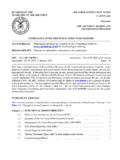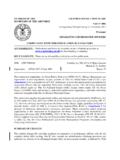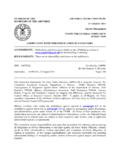Transcription of BY ORDER OF THE AIR FORCE INSTRUCTION 36-706 …
1 BY ORDER OF THE AIR FORCE INSTRUCTION 36-706 . secretary OF THE AIR FORCE . 22 MAY 2014 . personnel administrative grievance system . COMPLIANCE WITH THIS PUBLICATION IS MANDATORY. ACCESSIBILITY: Publications and forms are available for downloading or ordering on the e- Publishing website at RELEASABILITY: There are no releasability restrictions on this publication. OPR: AF/A1P Certified by: AF/A1. (Mr. Robert E. Corsi, Jr.). Pages: 14. Supersedes: AFI 36-1203, 1 May 1996. This INSTRUCTION implements AFPD 36-7, Employee and Labor-Management Relations, and Department of Defense Civilian personnel Manual Subchapter 771, The administrative grievance system . It contains guidance and procedures for considering non-bargaining civilian employee grievances. It reflects the policies of the secretary of the Air FORCE concerning matters that are discretionary within Air FORCE .
2 It applies to US citizen civilian employees of the Air FORCE who are paid from appropriated funds and who are either non-bargaining unit employees, or bargaining unit employees in a unit where no collective bargaining agreement has been negotiated, or where the negotiated procedure excludes the matters at issue. It also applies to supervisors, civilian personnel officers, career Senior Executive Service (SES), Senior Level (SL), Scientific or Professional (ST), and other management officials of Air FORCE . This INSTRUCTION applies to appropriated fund civilian employees, administered under Title 5, including Air FORCE Reserve personnel , United States citizens assigned to foreign overseas areas, and civilian employees at joint service organizations where Air FORCE is the executive agent. It does not apply to Air National Guard Technicians administered under Title 32.
3 It does not apply to applicants for employment. It also does not apply to matters that employees may appeal to Merit Systems Protection Board or matters covered by AFI 36-2706, Equal Opportunity Program Military and Civilian. In collaboration with the Chief of Air FORCE Reserve (AF/RE) and the Director of the Air National Guard (NGB/CF), the Deputy Chief of Staff for Manpower, personnel , and Services (AF/A1) develops personnel policy for administrative grievance system programs. This Air FORCE INSTRUCTION (AFI) may be supplemented at any level; MAJCOM-level supplements must be 2 AFI36-706 22 MAY 2014 . approved by the Human Resource Management Strategic Board (HSB) prior to certification and approval. Refer recommended changes and questions about this publication to the OPR listed above using the AF Form 847, Recommendation for Change of Publication; route AF Forms 847.
4 From the field through the appropriate chain of command. Requests for waivers must be submitted to the OPR listed above for consideration and approval. Ensure that all records created as a result of processes prescribed in this publication are maintained in accordance with Air FORCE Manual (AFMAN) 33-363, Management of Records, and disposed of in accordance with the Air FORCE Records Disposition Schedule (RDS) located in the Air FORCE Records Information Management system (AFRIMS). The subject publication has been reviewed for Information Collection and OMB Reporting requirements and have found data collection and reporting requirements that may need to be approved and licensed prior to collecting or gathering information from one or more DoD. component, other federal agencies, or the general public (to include contractors). The statement regarding the applicability of this INSTRUCTION to former Air FORCE employees with respect to matters arising during previous employment may trigger the Paperwork Reduction Act (PRA) of 1995.
5 Former Air FORCE employees are considered members of the general public. In accordance with the PRA and DoD policy, ensure that reports of information collections that are collected and/or is compiled and transmitted from the general public are cleared and licensed by OMB. prior to collection. SUMMARY OF CHANGES. This document has been substantially revised and must be completely reviewed. Major changes include: administrative revisions; moves the INSTRUCTION from AFPD 36-12 to AFPD 36-7;. clarifies Air FORCE policy in Chapter 1; clarifies authorities and responsibilities in Chapter 2;. deletes reference to the Civilian personnel Intelligence personnel system ; adds terms, definitions, and acronyms in Appendix 1; and adds compliance level tiers IAW AFI 36-360. Tier waiver authorities as approved by the Inspector General Advisory Board have been included per AFI 33-360, Publications and Forms Management.
6 Refer to AFI 33-360 for tier waiver authority definitions and procedures. AFI36-706 22 MAY 2014 3. Chapter 1. administrative grievance system (AGS). administrative grievance . This INSTRUCTION establishes a process under which an Air FORCE employee, or a group of employees, acting as individuals, may request personal relief in any matter of concern or dissatisfaction relating to conditions of employment of the employee(s). which are subject to the control of Air FORCE management. The goal of the AGS is to resolve workplace disputes early and at the lowest level possible. Civilian employees are entitled to present grievances under the AGS and have them considered and resolved expeditiously, fairly, and impartially. All persons involved in the grievance resolution process shall be free from restraint, interference, coercion, discrimination, or reprisal.
7 Alternative Dispute Resolution (ADR) processes and/or conflict management techniques should be used to resolve disputes, consistent with requirements of Air FORCE INSTRUCTION (AFI) 51-1201, Alternative Dispute Resolution Processes in Workplace Disputes. The Air FORCE will administer the AGS without unlawful discrimination because of race, color, religion, sex (including pregnancy), national origin, age (40 or older), disability, genetic information, or prior EEO activity. 4 AFI36-706 22 MAY 2014 . Chapter 2. AUTHORITIES AND RESPONSIBILITIES. Deputy administrative Assistant to the secretary of the Air FORCE (SAF/AA). SAF/AA. has been delegated by the secretary of the Air FORCE to be the final deciding official for certain grievances and disputes brought by and/or against certain senior officials. His/her decision is final. (T-0). Assistant secretary of the Air FORCE for Manpower and Reserve Affairs (SAF/MR).
8 SAF/MR serves as an agent of the secretary and provides guidance, direction, and oversight for all matters pertaining to the formulation, review, and execution of plans, policies, programs, and budgets addressing the administrative grievance system . (T-0). Deputy Chief of Staff of the Air FORCE , Manpower, personnel and Services (AF/A1). AF/A1 develops, coordinates, and executes personnel policy and essential procedural guidance for the management of the administrative grievance system . (T-0). Civilian FORCE Policy Division (AF/A1PC). AF/A1PC develops and implements policies that actively promote the AGS within Air FORCE . Oversees the implementation and administration of the AGS. Monitors and assesses the AGS to ensure compliance with DoD. regulations and this INSTRUCTION . (T-0). Air FORCE Senior Executive Management Office (AF/DPS). AF/DPS provides operational oversight, guidance and administration of the system for all Air FORCE Civilian Senior Executives.
9 AF/DPS serves as the principal policy and technical advisors to deciding officials and supervisors and assists them in processing and resolving grievances. (T-0). Air FORCE personnel Center (AFPC). AFPC provides operational oversight, guidance and training to Major Commands and Civilian personnel Sections (CPSs) on implementation procedures for AGS consistent with this INSTRUCTION . (T-0). Major Commands (MAJCOM), Direct Reporting Units (DRU), and Forward Operating Agencies, and Combatant Commands. The personnel Directors of Major Commands, Direct Reporting Units, and Forward Operating Agencies will oversee programs and ensure compliance with DoD regulations and this INSTRUCTION . (T-0). Civilian personnel (CPS). The CPS, in conjunction with management, develops procedures in accordance with the system outlined in this INSTRUCTION . CPSs serve as principal policy and technical advisors to deciding officials and supervisors and assist them in processing and resolving grievances.
10 This includes assisting deciding officials and supervisors in determining the most appropriate management official to represent the Air FORCE in any ADR. proceeding. CPSs are responsible for publicizing the grievance process and advise employees regarding grievance procedures. CPSs shall promote use of informal resolution techniques to resolve disputes early and at the lowest level possible. (T-0). Alternative Dispute Resolution (ADR) Managers. Assist commanders in setting ADR. policies and procedures and promoting the ADR programs among all organizations on the installation. Exercise oversight of the installation workplace ADR program, including conducting case intake, advising employees and management officials of their rights and options with AFI36-706 22 MAY 2014 5. respect to ADR, convening ADR proceedings, assigning neutrals, and coordinating on requests and compulsory processes to disclose confidential ADR communications.














